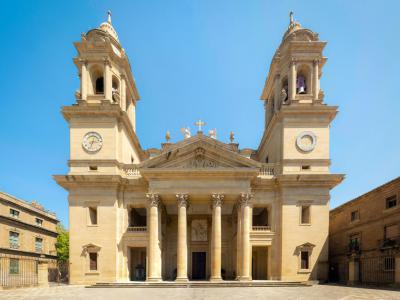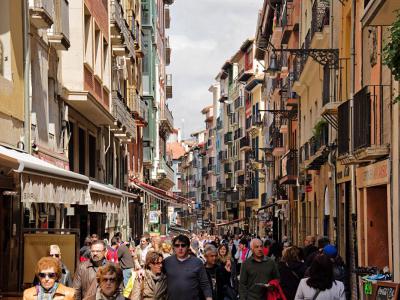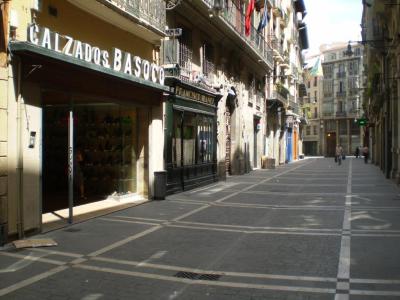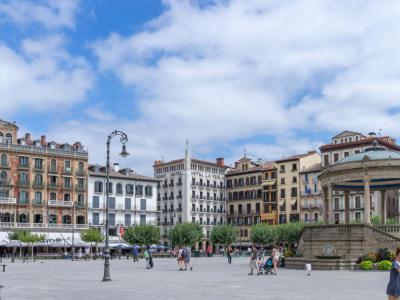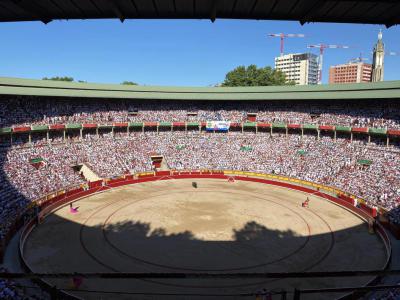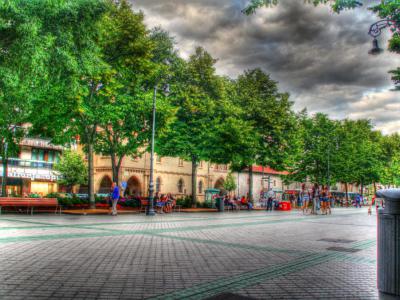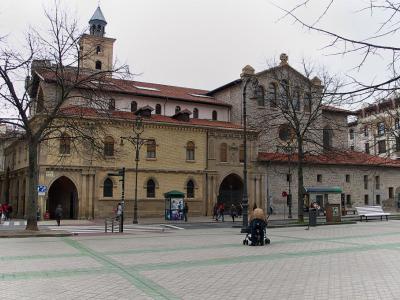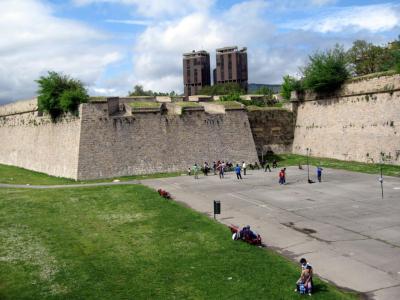
Pamplona Introduction Walking Tour (Self Guided), Pamplona
Pamplona, the capital of the autonomous region of Navarre in northern Spain, is one of the oldest cities in the country. Its history spans millennia. Originally a small Vascones settlement known as Iruña, it was transformed into a Roman city named Pompelo by the Roman commander Gnaeus Pompey in 74 BC. Over the centuries, Pamplona witnessed the rise and fall of various powers, from the Visigoths to the Muslims of Al-Andalus to the Carolingians.
Having changed hands numerous times, Pamplona finally became part of the united Spanish kingdom of Castile and Aragon in 1515. The city endured sieges during the French Revolution and occupation by the Napoleonic troops in the early 19th century.
During Franco's regime in the 20th century, Pamplona underwent significant industrialization. Despite the turbulent period of the 1950s and the challenges ensued from the transition from Francoism to democracy, the city continued to thrive, preserving its cultural heritage while embracing modernity.
Synonymous with the San Fermin festival, held annually between July 6 and 14, Pamplona is most famous for its “Running of the Bulls” event, seeing crowds of men chased by twelve angry bulls. The latter is immortalized in the Running of the Bulls Monument (Monumento al Encierro) as well as Ernest Hemingway's novel “The Sun Also Rises.” Wandering through the winding streets, you'll find yourself on the famed Estafeta Street (Calle de Estafeta), where the Running of the Bulls takes place.
Still, if you’re not visiting the city during these crazy days in July, there is lots to see. The majestic Pamplona Cathedral, a captivating fusion of architectural styles dating back to the 14th century, presides over the cityscape with its towering twin towers and Neoclassical facade.
At the heart of the city stands the elegant City Hall, a symbol of civic pride and governance. Nearby, Shoemaker Street (Calle de Zapatería) invites visitors to indulge in a shopping spree along its quaint cobblestone extent. Meanwhile, Plaza del Castillo, the bustling Castle Square, pulsates with life as a hub for celebrations and social gatherings.
The imposing Citadel of Pamplona, a 16th-century fortress, speaks volumes about the city's military prowess.
And if you seek solace and serenity away from the clamor of the streets, you can find it in the tranquil Taconera Park, a verdant oasis nestled within the city limits.
Pamplona's iconic landmarks narrate tales of its eventful past and vibrant present. Embark on a journey of discovery through its storied streets and discover the magic that awaits in this enchanting Spanish gem.
Having changed hands numerous times, Pamplona finally became part of the united Spanish kingdom of Castile and Aragon in 1515. The city endured sieges during the French Revolution and occupation by the Napoleonic troops in the early 19th century.
During Franco's regime in the 20th century, Pamplona underwent significant industrialization. Despite the turbulent period of the 1950s and the challenges ensued from the transition from Francoism to democracy, the city continued to thrive, preserving its cultural heritage while embracing modernity.
Synonymous with the San Fermin festival, held annually between July 6 and 14, Pamplona is most famous for its “Running of the Bulls” event, seeing crowds of men chased by twelve angry bulls. The latter is immortalized in the Running of the Bulls Monument (Monumento al Encierro) as well as Ernest Hemingway's novel “The Sun Also Rises.” Wandering through the winding streets, you'll find yourself on the famed Estafeta Street (Calle de Estafeta), where the Running of the Bulls takes place.
Still, if you’re not visiting the city during these crazy days in July, there is lots to see. The majestic Pamplona Cathedral, a captivating fusion of architectural styles dating back to the 14th century, presides over the cityscape with its towering twin towers and Neoclassical facade.
At the heart of the city stands the elegant City Hall, a symbol of civic pride and governance. Nearby, Shoemaker Street (Calle de Zapatería) invites visitors to indulge in a shopping spree along its quaint cobblestone extent. Meanwhile, Plaza del Castillo, the bustling Castle Square, pulsates with life as a hub for celebrations and social gatherings.
The imposing Citadel of Pamplona, a 16th-century fortress, speaks volumes about the city's military prowess.
And if you seek solace and serenity away from the clamor of the streets, you can find it in the tranquil Taconera Park, a verdant oasis nestled within the city limits.
Pamplona's iconic landmarks narrate tales of its eventful past and vibrant present. Embark on a journey of discovery through its storied streets and discover the magic that awaits in this enchanting Spanish gem.
How it works: Download the app "GPSmyCity: Walks in 1K+ Cities" from Apple App Store or Google Play Store to your mobile phone or tablet. The app turns your mobile device into a personal tour guide and its built-in GPS navigation functions guide you from one tour stop to next. The app works offline, so no data plan is needed when traveling abroad.
Pamplona Introduction Walking Tour Map






Guide Name: Pamplona Introduction Walking Tour
Guide Location: Spain » Pamplona (See other walking tours in Pamplona)
Guide Type: Self-guided Walking Tour (Sightseeing)
# of Attractions: 12
Tour Duration: 2 Hour(s)
Travel Distance: 2.8 Km or 1.7 Miles
Author: nataly
Sight(s) Featured in This Guide:
Guide Location: Spain » Pamplona (See other walking tours in Pamplona)
Guide Type: Self-guided Walking Tour (Sightseeing)
# of Attractions: 12
Tour Duration: 2 Hour(s)
Travel Distance: 2.8 Km or 1.7 Miles
Author: nataly
Sight(s) Featured in This Guide:
- Catedral de Pamplona (Pamplona Cathedral)
- Calle de Estafeta (Estafeta Street)
- Ayuntamiento de Pamplona (Pamplona City Hall)
- Calle de Zapateria (Shoemaker Street)
- Plaza del Castillo (Castle Square)
- Palacio de Navarra (Navarre Palace)
- Plaza de Toros de Pamplona (Pamplona Bullring)
- Monumento al Encierro (Running of the Bulls Monument)
- Paseo de Sarasate (Sarasate Promenade)
- Iglesia de San Nicolas (Church of San Nicolas)
- Ciudadela de Pamplona (Citadel of Pamplona)
- Parque de La Taconera (La Taconera Park)
1) Catedral de Pamplona (Pamplona Cathedral) (must see)
The Pamplona Cathedral is a captivating blend of architectural styles that reflects centuries of history in PamplonaInitially built upon the ruins of a 12th-century Romanesque church, the Cathedral evolved over time, becoming a significant stop along the medieval pilgrimage route to Santiago de Compostela. Its main structure, predominantly Gothic in style, dates back to the 14th and 15th centuries, while the Neoclassical facade, completed in 1799, adds a striking visual element with its towering twin towers that dominate the skyline.
Inside, visitors are greeted by a grandiose Gothic sanctuary adorned with intricate details and housing notable treasures such as the alabaster tomb of Charles III the Noble and his wife Leonora de Trastámara, crafted by Flemish master Jean de Lomme. The Capilla Mayor, or Main Chapel, boasts an exquisite Gothic retablo from 1507, showcasing fine sculptural craftsmanship. Additionally, the south aisle features a richly gilded doorway displaying the 14th-century tympanum Death of the Virgin, leading to the Claustro (Cloister), celebrated as one of Spain's finest medieval Gothic cloisters.
Preserving its Romanesque origins, the cathedral houses a crypt from the original church, along with a precious 12th-century carved figure of the Virgin Mary, symbolizing its enduring spiritual significance. For those eager to delve deeper into its treasures, the Diocesan Museum offers a fascinating journey through the cathedral's history, with lavishly decorated refectories and rooms displaying sacred art, including a 13th-century Gospel book and relics believed to include a fragment of the True Cross.
Inside, visitors are greeted by a grandiose Gothic sanctuary adorned with intricate details and housing notable treasures such as the alabaster tomb of Charles III the Noble and his wife Leonora de Trastámara, crafted by Flemish master Jean de Lomme. The Capilla Mayor, or Main Chapel, boasts an exquisite Gothic retablo from 1507, showcasing fine sculptural craftsmanship. Additionally, the south aisle features a richly gilded doorway displaying the 14th-century tympanum Death of the Virgin, leading to the Claustro (Cloister), celebrated as one of Spain's finest medieval Gothic cloisters.
Preserving its Romanesque origins, the cathedral houses a crypt from the original church, along with a precious 12th-century carved figure of the Virgin Mary, symbolizing its enduring spiritual significance. For those eager to delve deeper into its treasures, the Diocesan Museum offers a fascinating journey through the cathedral's history, with lavishly decorated refectories and rooms displaying sacred art, including a 13th-century Gospel book and relics believed to include a fragment of the True Cross.
2) Calle de Estafeta (Estafeta Street)
Spanning approximately 250 meters, Estafeta Street is renowned not only for its length but also for its historic significance and vibrant atmosphere, particularly during the San Fermín festivities. During this iconic event, Estafeta Street becomes one of the most popular routes for the running of the bulls, attracting hundreds of thousands of tourists from around the world to witness the thrilling spectacle.
Beyond its association with the running of the bulls, Estafeta Street is a bustling hub of activity year-round, adorned with a variety of shops, restaurants, and bars. It offers visitors and locals alike the opportunity to indulge in the best of local cuisine, with numerous establishments serving traditional Navarrese dishes alongside a wide selection of wines and beverages. Plaza del Castillo and neighboring streets like San Nicolás and Mercaderes are particularly renowned for their culinary offerings, making them prime destinations for experiencing the rich flavors of Navarre.
Formerly known by several names throughout history, Estafeta Street acquired its current name in the 19th century as a tribute to Pamplona's first post office. Its transformation into a bustling thoroughfare synonymous with the San Fermín festivities began in 1856, coinciding with the inauguration of the city's bullring located at the street's end. Today, it remains an integral part of the running of the bulls route, attracting thrill-seekers and spectators alike to witness the exhilarating spectacle unfold each year.
In addition to its cultural and historical significance, Estafeta Street holds a special place in the hearts of locals who frequent its establishments for tapas, or "pinchos" as they're known in the Basque Country and Navarre. From traditional dishes like asparagus and piquillo peppers stuffed with cod to more contemporary "haute cuisine" offerings such as foie gras skewers and gourmet croquettes, the street offers a culinary journey that reflects the region's rich gastronomic heritage.
Beyond its association with the running of the bulls, Estafeta Street is a bustling hub of activity year-round, adorned with a variety of shops, restaurants, and bars. It offers visitors and locals alike the opportunity to indulge in the best of local cuisine, with numerous establishments serving traditional Navarrese dishes alongside a wide selection of wines and beverages. Plaza del Castillo and neighboring streets like San Nicolás and Mercaderes are particularly renowned for their culinary offerings, making them prime destinations for experiencing the rich flavors of Navarre.
Formerly known by several names throughout history, Estafeta Street acquired its current name in the 19th century as a tribute to Pamplona's first post office. Its transformation into a bustling thoroughfare synonymous with the San Fermín festivities began in 1856, coinciding with the inauguration of the city's bullring located at the street's end. Today, it remains an integral part of the running of the bulls route, attracting thrill-seekers and spectators alike to witness the exhilarating spectacle unfold each year.
In addition to its cultural and historical significance, Estafeta Street holds a special place in the hearts of locals who frequent its establishments for tapas, or "pinchos" as they're known in the Basque Country and Navarre. From traditional dishes like asparagus and piquillo peppers stuffed with cod to more contemporary "haute cuisine" offerings such as foie gras skewers and gourmet croquettes, the street offers a culinary journey that reflects the region's rich gastronomic heritage.
3) Ayuntamiento de Pamplona (Pamplona City Hall) (must see)
The Pamplona City Hall stands as a majestic emblem of the city's rich history and architectural splendor. Located northwest of the Plaza del Castillo on the Plaza Consistorial, this impressive 17th-century building commands attention with its ornate Baroque facade adorned with colorful flags swaying in the breeze.
Dating back to the 17th century, the City Hall is a testament to the skilled craftsmanship and artistic vision of its time. Adorned with intricate stone columns and statues, the building exudes grandeur and elegance. Its facade, constructed from ochre sandstone, features majestic lions bearing coats of arms and a trumpet-blowing allegorical figure of Fame.
Beyond its architectural magnificence, the Ayuntamiento de Pamplona serves as a focal point for significant cultural events, most notably the annual Bull Festival, which commences with the mayor's announcement on July 6th each year. This renowned event, popular with tourists and participants alike, features the iconic running of the bulls, adding to the vibrancy and excitement that permeates the city's streets.
Moreover, the Casa Consistorial, housed within the Ayuntamiento, holds historical significance as the starting point for the famous bull runs, further solidifying its importance in Pamplona's cultural identity.
Dating back to the 17th century, the City Hall is a testament to the skilled craftsmanship and artistic vision of its time. Adorned with intricate stone columns and statues, the building exudes grandeur and elegance. Its facade, constructed from ochre sandstone, features majestic lions bearing coats of arms and a trumpet-blowing allegorical figure of Fame.
Beyond its architectural magnificence, the Ayuntamiento de Pamplona serves as a focal point for significant cultural events, most notably the annual Bull Festival, which commences with the mayor's announcement on July 6th each year. This renowned event, popular with tourists and participants alike, features the iconic running of the bulls, adding to the vibrancy and excitement that permeates the city's streets.
Moreover, the Casa Consistorial, housed within the Ayuntamiento, holds historical significance as the starting point for the famous bull runs, further solidifying its importance in Pamplona's cultural identity.
4) Calle de Zapateria (Shoemaker Street)
The Shoemaker Street weaves through the heart of the Old Town, offering visitors a glimpse into the city's rich history and vibrant atmosphere. Lined with quaint souvenir shops, traditional product stores, and pintxos bars, this atmospheric street exudes charm and character. Dating back to 1700, it was once considered one of the wealthiest streets in the city, a fact evidenced by the preserved baroque buildings and numerous coats of arms that still adorn many of the houses along its path.
Among the notable landmarks along Calle de Zapateria are the Palace of the Counts of Guendulain and the Palace of the Navarro Tafalla. The former, now converted into a luxury hotel, stands as a testament to Pamplona's aristocratic past, while the latter, commissioned in 1752, reflects the city's architectural heritage.
Originally serving as the hub for the shoemakers' guild, Calle de Zapateria has witnessed a transformation over the years, with various businesses flourishing along its cobblestone streets. In the mid-20th century, establishments ranging from tobacconists to grocery stores and textile fashion outlets thrived here, contributing to the street's vibrant commercial life.
However, in recent years, Calle de Zapateria has experienced changes as many longstanding businesses have closed their shutters. Some closures have been attributed to the retirement of owners, while others have been driven by increased competition from larger stores or relocations to different areas. Despite these shifts, the street retains its allure, offering visitors a blend of historical charm and contemporary energy.
Among the notable landmarks along Calle de Zapateria are the Palace of the Counts of Guendulain and the Palace of the Navarro Tafalla. The former, now converted into a luxury hotel, stands as a testament to Pamplona's aristocratic past, while the latter, commissioned in 1752, reflects the city's architectural heritage.
Originally serving as the hub for the shoemakers' guild, Calle de Zapateria has witnessed a transformation over the years, with various businesses flourishing along its cobblestone streets. In the mid-20th century, establishments ranging from tobacconists to grocery stores and textile fashion outlets thrived here, contributing to the street's vibrant commercial life.
However, in recent years, Calle de Zapateria has experienced changes as many longstanding businesses have closed their shutters. Some closures have been attributed to the retirement of owners, while others have been driven by increased competition from larger stores or relocations to different areas. Despite these shifts, the street retains its allure, offering visitors a blend of historical charm and contemporary energy.
5) Plaza del Castillo (Castle Square) (must see)
The Castle Square stands as the vibrant heart and nerve center of Pamplona, with its expansive almost 14,000 square meters having played a pivotal role throughout the city's storied history. Its name harkens back to the castle that once graced its eastern part, built by Luis Hutín in 1310 and serving as a parade ground overlooking the square. During the Middle Ages, the Castle Square served as a neutral zone amid conflicts between three towns, boasting military significance alongside its role as a market in 1324 and an agricultural area for herbs and wheat in the 14th century.
Since 1405, it has hosted a plethora of celebrations and fairs commemorating monarchical anniversaries and the city's patron saints. Additionally, the Castle Square served as the primary venue for bullfights from 1385 to 1844, highlighting its multifaceted role in Pamplona's cultural landscape.
Over the centuries, the Castle Square has witnessed a remarkable evolution, with its functions transitioning from military parades and bullfights to leisurely pursuits such as cafes and social gatherings. The center kiosk, erected in 1943, replaced an earlier wooden structure from 1910, which itself replaced the 18th-century Beneficencia fountain by Luis Paret. Although the original Mariblanca statue from the fountain now resides in the Taconera gardens, the Castle Square continues to serve as a vibrant focal point within Pamplona's urban fabric, embodying the city's rich history and enduring spirit.
Since 1405, it has hosted a plethora of celebrations and fairs commemorating monarchical anniversaries and the city's patron saints. Additionally, the Castle Square served as the primary venue for bullfights from 1385 to 1844, highlighting its multifaceted role in Pamplona's cultural landscape.
Over the centuries, the Castle Square has witnessed a remarkable evolution, with its functions transitioning from military parades and bullfights to leisurely pursuits such as cafes and social gatherings. The center kiosk, erected in 1943, replaced an earlier wooden structure from 1910, which itself replaced the 18th-century Beneficencia fountain by Luis Paret. Although the original Mariblanca statue from the fountain now resides in the Taconera gardens, the Castle Square continues to serve as a vibrant focal point within Pamplona's urban fabric, embodying the city's rich history and enduring spirit.
6) Palacio de Navarra (Navarre Palace)
The Navarre Palace serves as the prestigious headquarters of the Presidency of the Government and various administrative offices of the Foral Community in Pamplona, Spain. Designed in 1840 by José de Nagusia, this grandiose complex epitomizes the neoclassical architectural style, exuding an aura of seriousness, power, and solemnity. The exterior of the palace is adorned with numerous columns, adding to its majestic appearance and commanding presence within the city center.
Inside the Navarre Palace, visitors are greeted by the noble area, known as the Throne Room, which exudes majesty and splendor through its opulent decoration, symbolizing authority and prestige. Notable features include an exuberant tapestry depicting the great battle of Las Navas de Tolosa in 1212 and a striking portrait of Ferdinand VII by the renowned artist Francisco de Goya, housed in the office of the President of the Navarrese Executive. The palace's outdoor garden boasts a towering giant sequoia, the tallest tree in the city, adding a touch of natural beauty to the surroundings.
Popularly referred to as "the Provincial Council," the Navarre Palace serves as the nerve center of the autonomous Government, embodying the region's rich history and cultural heritage. Its neoclassical facade, facing the Fueros monument on Paseo de Sarasate, and the Plaza del Castillo, features a sculptural group by Fructuoso Orduna (1951), showcasing the coat of arms of Navarra flanked by two symbolic figures representing the mountain and river. Despite bearing the scars of a bombing during the Spanish Civil War, the palace stands as a resilient symbol of Navarre's enduring spirit and commitment to governance and tradition.
Inside the Navarre Palace, visitors are greeted by the noble area, known as the Throne Room, which exudes majesty and splendor through its opulent decoration, symbolizing authority and prestige. Notable features include an exuberant tapestry depicting the great battle of Las Navas de Tolosa in 1212 and a striking portrait of Ferdinand VII by the renowned artist Francisco de Goya, housed in the office of the President of the Navarrese Executive. The palace's outdoor garden boasts a towering giant sequoia, the tallest tree in the city, adding a touch of natural beauty to the surroundings.
Popularly referred to as "the Provincial Council," the Navarre Palace serves as the nerve center of the autonomous Government, embodying the region's rich history and cultural heritage. Its neoclassical facade, facing the Fueros monument on Paseo de Sarasate, and the Plaza del Castillo, features a sculptural group by Fructuoso Orduna (1951), showcasing the coat of arms of Navarra flanked by two symbolic figures representing the mountain and river. Despite bearing the scars of a bombing during the Spanish Civil War, the palace stands as a resilient symbol of Navarre's enduring spirit and commitment to governance and tradition.
7) Plaza de Toros de Pamplona (Pamplona Bullring)
Constructed in 1922, thу historic Pamplona Bullring serves as a venue for bullfighting, sporting events, cultural performances, and music concerts, attracting thousands of spectators from around the world. With a seating capacity of 19,720 people, the stadium provides an electrifying atmosphere for a diverse range of events.
One of the most renowned aspects of the Pamplona Bullring is its association with the annual festival of San Fermín and the infamous "Running of the Bulls." Each year, during the festival, participants run alongside six charging bulls through the streets of Pamplona, culminating in the bullring. The bullring serves as the dramatic endpoint of this exhilarating event, where the bulls are later fought in traditional bullfights, showcasing the intersection of tradition, adrenaline, and cultural significance.
However, the Pamplona Bullring also holds a somber chapter in its history. During the final months of the Spanish Civil War in 1939, the bullring was repurposed as a Francoist concentration camp, housing thousands of Republican prisoners. This period serves as a reminder of the complex and often tragic history that surrounds the bullring, highlighting its multifaceted role in shaping the identity of Pamplona and its people.
One of the most renowned aspects of the Pamplona Bullring is its association with the annual festival of San Fermín and the infamous "Running of the Bulls." Each year, during the festival, participants run alongside six charging bulls through the streets of Pamplona, culminating in the bullring. The bullring serves as the dramatic endpoint of this exhilarating event, where the bulls are later fought in traditional bullfights, showcasing the intersection of tradition, adrenaline, and cultural significance.
However, the Pamplona Bullring also holds a somber chapter in its history. During the final months of the Spanish Civil War in 1939, the bullring was repurposed as a Francoist concentration camp, housing thousands of Republican prisoners. This period serves as a reminder of the complex and often tragic history that surrounds the bullring, highlighting its multifaceted role in shaping the identity of Pamplona and its people.
8) Monumento al Encierro (Running of the Bulls Monument) (must see)
The Running of the Bulls Monument stands as a striking tribute to the exhilarating tradition of the Sanfermines running of the bulls in Pamplona. Crafted by the renowned Bilbao sculptor Rafael Huerta, the monument was inaugurated on July 6, 1994, and later expanded in 2007 to its current impressive form. Realistically capturing the expressiveness and dynamism of the bull runs, the monument portrays a hectic moment where runners are overtaken by charging bulls, encapsulating the adrenaline-fueled intensity of the event.
Composed of bronze, the sculptural group features nineteen figures, including six powerful bulls by Victorino Martín, three halteros, and ten runners. Stretching 11 meters in length and 4 meters in width, the monument stands atop a reinforced concrete pedestal, creating a harmonious and impactful composition. The extension added in 2007 was based on the original sculpture from 1994, which depicted only two runners and one bull. At the request of the Pamplona City Council, Rafael Huerta expanded the monument to better capture the essence of the event.
Huerta's vision for the Running of the Bulls Monument aimed to freeze a moment of frenetic action and stampede, conveying the essence of the bull runs with remarkable detail and emotion. Notably, the sculptor included a self-portrait lying on the ground within one of the corridors, adding a personal touch to the artwork. Originally, the monument featured representations of specific individuals, including Julen Madina and councilor Ignacio Pérez Cabañas, both San Fermín runners. However, due to social pressure, their likenesses were removed, leaving the identities of the remaining runners anonymous, symbolizing the collective spirit and universal appeal of the Sanfermines tradition.
Composed of bronze, the sculptural group features nineteen figures, including six powerful bulls by Victorino Martín, three halteros, and ten runners. Stretching 11 meters in length and 4 meters in width, the monument stands atop a reinforced concrete pedestal, creating a harmonious and impactful composition. The extension added in 2007 was based on the original sculpture from 1994, which depicted only two runners and one bull. At the request of the Pamplona City Council, Rafael Huerta expanded the monument to better capture the essence of the event.
Huerta's vision for the Running of the Bulls Monument aimed to freeze a moment of frenetic action and stampede, conveying the essence of the bull runs with remarkable detail and emotion. Notably, the sculptor included a self-portrait lying on the ground within one of the corridors, adding a personal touch to the artwork. Originally, the monument featured representations of specific individuals, including Julen Madina and councilor Ignacio Pérez Cabañas, both San Fermín runners. However, due to social pressure, their likenesses were removed, leaving the identities of the remaining runners anonymous, symbolizing the collective spirit and universal appeal of the Sanfermines tradition.
9) Paseo de Sarasate (Sarasate Promenade)
Renowned for its charm and significance, Pablo Sarasate Promenade, also popularly referred to as Valencia Promenade, serves as a focal point for various cultural events and gatherings, making it a vibrant hub within the city.
One of the distinguishing features of Sarasate Promenade is the six white stone statues adorning its central platform. These statues, representing kings, were originally intended for the decorative project of the Royal Palace of Madrid (Palacio de Oriente) in the 19th century but were ultimately acquired by the Pamplona City Council. Crafted between 1750 and 1753, the statues underwent a significant change in 1972 when two of them, depicting Ferdinand VI and his wife Bárbara de Braganza, were returned to Madrid. In exchange, two new statues representing the kings of Navarra, Felipe III of Navarra and García Ramírez, were brought to Pamplona. Notably, these latter two statues are the only ones whose names appear on the pedestal, while the identities of the other four statues remain unknown, adding an air of mystery to the promenade.
Throughout its history, Sarasate Promenade has served as a gathering place for locals and visitors alike, offering a scenic and inviting environment for leisurely strolls and cultural activities. The promenade's picturesque setting, flanked by elegant trees and historic buildings, creates an idyllic backdrop for relaxation and socialization. Additionally, its central location makes it a strategic point for various events and celebrations, further enhancing its significance as a cherished landmark in the heart of Pamplona.
One of the distinguishing features of Sarasate Promenade is the six white stone statues adorning its central platform. These statues, representing kings, were originally intended for the decorative project of the Royal Palace of Madrid (Palacio de Oriente) in the 19th century but were ultimately acquired by the Pamplona City Council. Crafted between 1750 and 1753, the statues underwent a significant change in 1972 when two of them, depicting Ferdinand VI and his wife Bárbara de Braganza, were returned to Madrid. In exchange, two new statues representing the kings of Navarra, Felipe III of Navarra and García Ramírez, were brought to Pamplona. Notably, these latter two statues are the only ones whose names appear on the pedestal, while the identities of the other four statues remain unknown, adding an air of mystery to the promenade.
Throughout its history, Sarasate Promenade has served as a gathering place for locals and visitors alike, offering a scenic and inviting environment for leisurely strolls and cultural activities. The promenade's picturesque setting, flanked by elegant trees and historic buildings, creates an idyllic backdrop for relaxation and socialization. Additionally, its central location makes it a strategic point for various events and celebrations, further enhancing its significance as a cherished landmark in the heart of Pamplona.
10) Iglesia de San Nicolas (Church of San Nicolas)
The Church of San Nicolas, situated along the grand Sarasate Promenade, stands as a testament to centuries of history and architectural evolution. Constructed in the 12th century, the church originally boasted a Romanesque architectural style, distinguishing it as one of the oldest churches in the city. Remarkably, San Nicolás is the sole church in Pamplona to have preserved its original Romanesque structure, predominantly visible in its exterior facades.
Throughout its storied past, the Church of San Nicolas served as a stronghold for the San Nicolas quarter, embodying both religious and defensive significance. However, much of the church's original fortress-like structure was tragically destroyed during a Castilian invasion of the town, leaving behind remnants of its ancient architecture mainly visible on the exterior. Despite the devastation, the interior of the church underwent extensive renovations in the Gothic style, resulting in a captivating space characterized by a vaulted nave and intricate stained-glass windows, which imbue the sanctuary with an aura of spiritual grandeur and artistic beauty.
Today, the Church of San Nicolas remains an integral part of Pamplona's cultural and religious landscape, welcoming visitors for worship and cultural exploration on a daily basis. Mass is celebrated within its hallowed walls every day, offering locals and tourists alike the opportunity to experience the solemnity and reverence of religious tradition. Furthermore, the church's vibrant connection to local festivities is showcased annually during the Fiesta de San Blas on February 3rd, marked by a lively street market. Here, attendees can indulge in special regional delicacies such as roscos, caramelos, and piperropiles, celebrating both religious tradition and culinary heritage amidst the timeless ambiance of the historic Iglesia de San Nicolás.
Throughout its storied past, the Church of San Nicolas served as a stronghold for the San Nicolas quarter, embodying both religious and defensive significance. However, much of the church's original fortress-like structure was tragically destroyed during a Castilian invasion of the town, leaving behind remnants of its ancient architecture mainly visible on the exterior. Despite the devastation, the interior of the church underwent extensive renovations in the Gothic style, resulting in a captivating space characterized by a vaulted nave and intricate stained-glass windows, which imbue the sanctuary with an aura of spiritual grandeur and artistic beauty.
Today, the Church of San Nicolas remains an integral part of Pamplona's cultural and religious landscape, welcoming visitors for worship and cultural exploration on a daily basis. Mass is celebrated within its hallowed walls every day, offering locals and tourists alike the opportunity to experience the solemnity and reverence of religious tradition. Furthermore, the church's vibrant connection to local festivities is showcased annually during the Fiesta de San Blas on February 3rd, marked by a lively street market. Here, attendees can indulge in special regional delicacies such as roscos, caramelos, and piperropiles, celebrating both religious tradition and culinary heritage amidst the timeless ambiance of the historic Iglesia de San Nicolás.
11) Ciudadela de Pamplona (Citadel of Pamplona) (must see)
The Citadel of Pamplona stands as a remarkable Renaissance fortification in the shape of a pentagon, adorned with bastions and ravelins. Initiated by Philip II under the guidance of the military engineer Giovan Giacomo Paleari Fratino, known as "El Fratín," the Citadel's construction began in 1571.
Originally conceived as a defensive stronghold to protect Pamplona from French incursions, the Citadel is hailed as one of the most outstanding examples of military architecture from the Spanish Renaissance era. Its strategic design and imposing structure have earned it recognition as one of the premier defensive complexes in Europe.
Over the centuries, the Citadel has evolved from its original military purpose to become a vibrant public space for cultural and leisure activities. In 1964, it was transferred to the Pamplona City Council, paving the way for its transformation into a public cultural and recreational area. Covering an expansive area of 280,000 square meters, the Citadel encompasses pavilions, moats, bastions, ravelins, and smaller buildings, which now serve as public venues for leisure, sports, and cultural events.
Today, the Citadel complex and its surrounding Castle Vault represent the largest green space in Pamplona, offering a serene oasis amidst the bustling cityscape. The Citadel's expansive grounds host a diverse array of recreational activities and cultural events, attracting residents and tourists seeking respite and entertainment. Additionally, the Citadel's grounds feature an impressive collection of sculptures by renowned artists such as Oteiza, Aizkorbe, Sada, JA Eslava, Orella, Larrea, Aguirre, Basterretxea, Anda, and Gabino, further enhancing its status as a cultural hub and a testament to Pamplona's rich artistic heritage.
Originally conceived as a defensive stronghold to protect Pamplona from French incursions, the Citadel is hailed as one of the most outstanding examples of military architecture from the Spanish Renaissance era. Its strategic design and imposing structure have earned it recognition as one of the premier defensive complexes in Europe.
Over the centuries, the Citadel has evolved from its original military purpose to become a vibrant public space for cultural and leisure activities. In 1964, it was transferred to the Pamplona City Council, paving the way for its transformation into a public cultural and recreational area. Covering an expansive area of 280,000 square meters, the Citadel encompasses pavilions, moats, bastions, ravelins, and smaller buildings, which now serve as public venues for leisure, sports, and cultural events.
Today, the Citadel complex and its surrounding Castle Vault represent the largest green space in Pamplona, offering a serene oasis amidst the bustling cityscape. The Citadel's expansive grounds host a diverse array of recreational activities and cultural events, attracting residents and tourists seeking respite and entertainment. Additionally, the Citadel's grounds feature an impressive collection of sculptures by renowned artists such as Oteiza, Aizkorbe, Sada, JA Eslava, Orella, Larrea, Aguirre, Basterretxea, Anda, and Gabino, further enhancing its status as a cultural hub and a testament to Pamplona's rich artistic heritage.
12) Parque de La Taconera (La Taconera Park) (must see)
La Taconera Park is the city's oldest and most enchanting green space. Designed in 1830, the park exudes a romantic ambiance with its French-style gardens, offering visitors a tranquil retreat from the bustling urban environment. Originally constructed as a bastion in the 17th century to reinforce the city's defenses, the Taconera bastion underwent transformation around 1940, replacing its military infrastructure with a stone parapet to accommodate leisurely strolls and promenades.
As visitors wander through La Taconera Park, they are greeted by a picturesque landscape adorned with a diverse array of trees and plants. Towering beeches, majestic magnolia trees, and unique ginkgos biloba punctuate the park's greenery, creating a serene backdrop for leisurely walks. Alongside these botanical wonders, laurels, hollies, and a towering sequoia tree measuring 40 meters in height contribute to the park's lush and vibrant atmosphere. One of the park's highlights is the charming Café Vienés, housed within a former bicycle rental kiosk, where visitors can relax amidst the tranquil surroundings.
Beyond its botanical delights, La Taconera Park boasts a small open-air zoo, offering glimpses of wildlife amid its verdant landscape. Ducks, swans, deer, peacocks, pheasants, geese, and fish inhabit the park's moats, adding an element of enchantment to the park experience. Additionally, the park serves as a veritable outdoor museum, adorned with several sculptures that adorn its pathways. Notable among these is the Monument to Julián Gayarre, crafted by Fructuoso Orduna in 1950, which graces the central promenade. Other sculptures, including a bust honoring the composer Hilarión Eslava and the Monument to Charity, known as "La Mari Blanca," further enrich the park's cultural landscape.
As visitors wander through La Taconera Park, they are greeted by a picturesque landscape adorned with a diverse array of trees and plants. Towering beeches, majestic magnolia trees, and unique ginkgos biloba punctuate the park's greenery, creating a serene backdrop for leisurely walks. Alongside these botanical wonders, laurels, hollies, and a towering sequoia tree measuring 40 meters in height contribute to the park's lush and vibrant atmosphere. One of the park's highlights is the charming Café Vienés, housed within a former bicycle rental kiosk, where visitors can relax amidst the tranquil surroundings.
Beyond its botanical delights, La Taconera Park boasts a small open-air zoo, offering glimpses of wildlife amid its verdant landscape. Ducks, swans, deer, peacocks, pheasants, geese, and fish inhabit the park's moats, adding an element of enchantment to the park experience. Additionally, the park serves as a veritable outdoor museum, adorned with several sculptures that adorn its pathways. Notable among these is the Monument to Julián Gayarre, crafted by Fructuoso Orduna in 1950, which graces the central promenade. Other sculptures, including a bust honoring the composer Hilarión Eslava and the Monument to Charity, known as "La Mari Blanca," further enrich the park's cultural landscape.
The Most Popular Cities
/ view all
